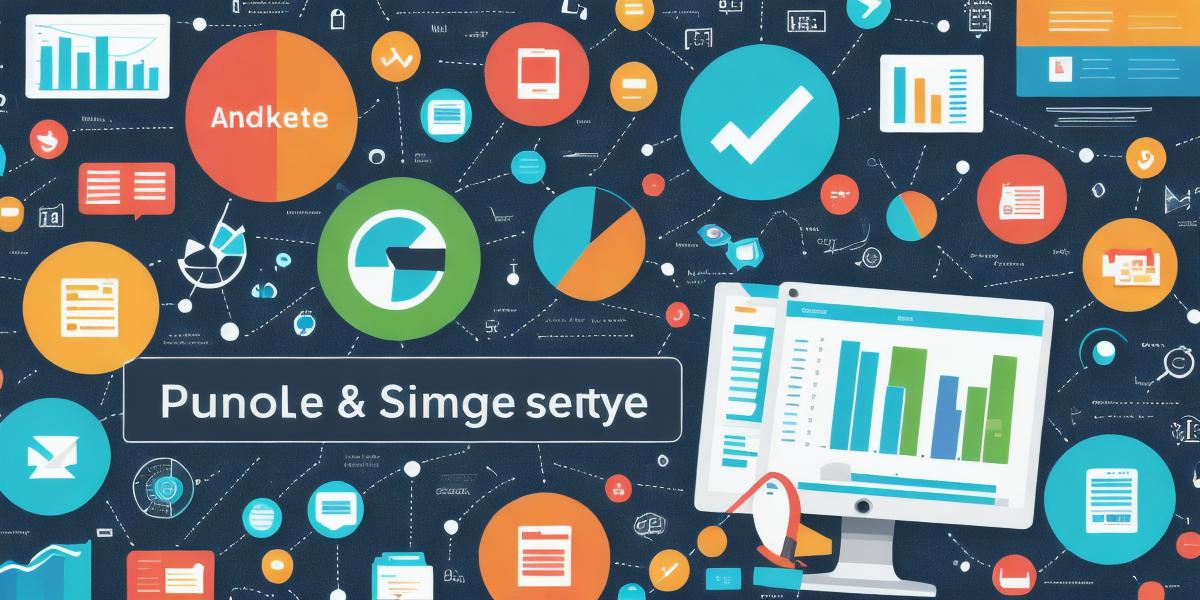In today’s digital age, data has become an essential asset for businesses looking to stay ahead of their competition. However, collecting and analyzing data can be a daunting task for even the most experienced marketers. This is where marketing research tools come in handy. In this guide, we will explore some of the most commonly used marketing research tools for data analysis and insights.
I. Introduction
A. Importance of Marketing Research
B. Overview of the Guide

II. Surveys and Questionnaires
A. Definition of Surveys and Questionnaires
B. Types of Surveys and Questionnaires

C. Benefits of Surveys and Questionnaires
D. Common Survey Tools
E. Tips for Conducting Effective Surveys
III. Focus Groups
A. Definition of Focus Groups
B. Types of Focus Groups
C. Benefits of Focus Groups
D. How to Conduct Focus Groups
E. Analysis Techniques for Focus Groups
IV. Interviews
A. Definition of Interviews
B. Types of Interviews
C. Benefits of Interviews
D. How to Conduct Interviews
E. Analysis Techniques for Interviews
V. In-Depth Interviews
A. Definition of In-Depth Interviews
B. Advantages and Disadvantages of In-Depth Interviews
C. How to Conduct In-Depth Interviews
D. Analysis Techniques for In-Depth Interviews
VI. Case Studies
A. Definition of Case Studies
B. Benefits of Case Studies
C. How to Conduct Case Studies
D. Analysis Techniques for Case Studies
E. Real-Life Examples of Case Studies in Marketing
VII. Online Analytics Tools
A. Overview of Online Analytics Tools
B. Types of Online Analytics Tools
C. Benefits of Online Analytics Tools
D. Common Online Analytics Tools
E. How to Use Online Analytics Tools for Data Analysis
VIII. Conclusion
A. Recap of Marketing Research Tools
B. Importance of Continuous Learning and Improvement in Marketing
C. Final Thoughts on the Future of Marketing Research
IX. FAQs
A. Frequently Asked Questions
B. Answers to Common Misconceptions
C. Recommendations for Further Reading
Introduction: The Importance of Marketing Research
Marketing research is a vital component of any marketing strategy. It allows businesses to gather valuable insights into their target audience, identify trends and opportunities in the market, and make data-driven decisions that can help them achieve their goals. In this guide, we will explore some of the most commonly used marketing research tools for data analysis and insights.
II. Surveys and Questionnaires
: The Basics of Data Collection
Surveys and questionnaires are two of the most popular ways to collect data from customers. They can be conducted online or offline, and they allow businesses to gather information on a wide range of topics, including customer satisfaction, product preferences, and purchasing behavior.
A. Definition of Surveys and Questionnaires
A survey is a systematic collection of data through the use of a questionnaire. A questionnaire is a set of questions designed to elicit information from respondents. Surveys and questionnaires can be used to collect both quantitative and qualitative data.
B. Types of Surveys and Questionnaires
There are several types of surveys and questionnaires, including:
1. Cross-sectional surveys: These surveys are conducted at a single point in time and are used to gather information on a specific topic or issue.
2. Longitudinal surveys: These surveys are conducted over an extended period of time and are used to track changes in attitudes, behaviors, and other variables over time.
3. Self-report surveys: These surveys are completed by the respondent themselves and can be conducted online or offline.
4. Phone surveys: These surveys are conducted over the phone and are typically used for more sensitive topics or when a large sample size is required.
5. In-person surveys: These surveys are conducted in person and are typically used for highly sensitive or complex topics that require face-to-face interaction.
C. Benefits of Surveys and Questionnaires
Surveys and questionnaires offer several benefits, including:
1. Cost-effective: Surveys and questionnaires are a cost-effective way to collect data from a large sample size.
2. Objective: Surveys and questionnaires allow businesses to gather objective data that can be analyzed and used to make informed decisions.
3. Customizable: Surveys and questionnaires can be customized to suit the specific needs of a business or organization.
4. Accessible: Surveys and questionnaires can be conducted online or offline, making them accessible to a wide range of respondents.
D. Common Survey Tools
There are many survey tools available, including:
1. Google Forms: A free online survey tool that allows businesses to create custom surveys and collect data from respondents.
2. SurveyMonkey: A popular online survey tool that offers a range of features, including the ability to customize surveys, export data, and analyze results.
3. Typeform: A user-friendly survey tool that allows businesses to create interactive forms and collect data from respondents.
4. Zoho Forms: An online survey tool that integrates with other Zoho applications, making it easy for businesses to manage and analyze data.
5. Microsoft Forms: A cloud-based survey tool that offers a range of features, including the ability to share surveys, collect data, and analyze results.
E. Tips for Conducting Effective Surveys
To conduct an effective survey, businesses should consider the following tips:
1. Define your objectives: Before creating a survey, it’s important to define your objectives and determine what information you need to collect from respondents.
2. Keep it simple: Surveys should be easy to understand and complete. Avoid using jargon or complex language that may confuse respondents.
3. Use clear questions: Questions should be clear, concise, and specific. Avoid open-ended questions that may elicit irrelevant responses.
4. Use a mix of question types: Surveys should include a mix of question types, including multiple choice, rating scales, and open-ended questions.
5. Test your survey: Before distributing your survey to a large sample size, test it with a small group of respondents to identify any issues or areas for improvement.
III. Focus Groups: In-Depth Analysis of Customer Needs
Focus groups are a qualitative research method that allows businesses to gather in-depth information about their target audience. Focus groups typically consist of a small group of people who share similar characteristics, such as age, gender, or income level.
A. Definition of Focus Groups
A focus group is a qualitative research method that involves a small group of people discussing their attitudes, behaviors, and experiences in response to specific prompts. Focus groups are typically conducted in person, although they can also be conducted online.
B. Types of Focus Groups
There are several types of focus groups, including:
1. Homogeneous focus groups: These focus groups consist of people who share similar characteristics, such as age, gender, or income level.
2. Heterogeneous focus groups: These focus groups consist of people who have different characteristics, such as age, gender, or income level.
3. In-depth focus groups: These focus groups are conducted over an extended period of time and allow businesses to gather in-depth information about a specific topic or issue.
4. Online focus groups: These focus groups are conducted online and allow businesses to gather information from respondents who may not be able to attend in person.
C. Benefits of Focus Groups
Focus groups offer several benefits, including:
1. In-depth analysis: Focus groups allow businesses to gather in-depth information about their target audience, including attitudes, behaviors, and experiences.
2. Validation: Focus groups can be used to validate or disprove hypotheses and assumptions about customer needs and preferences.
3. Flexibility: Focus groups can be conducted in person or online, making them accessible to a wide range of respondents.
4. Cost-effective: Focus groups are typically less expensive than other research methods, such as surveys or experiments.
D. Common Focus Group Tools
There are many focus group tools available, including:
1. Zoom: A popular online meeting platform that can be used to conduct focus groups remotely.
2. Skype: Another online meeting platform that can be used for remote focus groups.
3. Google Meet: An online meeting platform that can be used for remote focus groups and allows businesses to share screens and collaborate in real-time.
4. Focus Group Central: A web-based focus group tool that offers a range of features, including the ability to record focus groups and analyze results.
5. Moodtrackers: An online focus group tool that allows businesses to conduct focus groups remotely and collect data from respondents in real-time.
E. Tips for Conducting Effective Focus Groups
To conduct an effective focus group, businesses should consider the following tips:
1. Define your objectives: Before conducting a focus group, it’s important to define your objectives and determine what information you need to collect from respondents.
2. Recruit participants: Participants for focus groups should be selected based on their relevant characteristics, such as age, gender, or income level.
3. Prepare questions: Focus group questions should be clear, concise, and specific. Avoid open-ended questions that may elicit irrelevant responses.
4. Conduct the focus group: Focus groups should be conducted in a comfortable and relaxed environment, allowing respondents to feel at ease and share their thoughts and experiences freely.
5. Analyze the data: Focus group data should be analyzed carefully, looking for patterns, themes, and insights that can be used to inform business decisions.
IV. In-Depth Analysis of Customer Needs with Case Studies
Case studies are a qualitative research method that involves analyzing in-depth a single case or situation, such as a company’s marketing strategy or product development process. Case studies can provide valuable insights into customer needs and preferences, as well as best practices for businesses to adopt.
A. Definition of Case Studies
A case study is an in-depth analysis of a single case or situation, typically conducted through interviews, observations, and document analysis. Case studies can be used to explore a wide range of topics, including business strategy, product development, and customer behavior.
B. Benefits of Case Studies
Case studies offer several benefits, including:
1. In-depth analysis: Case studies allow businesses to gain a deep understanding of a specific situation or case, providing valuable insights into customer needs and preferences.
2. Best practices: Case studies can identify best practices for businesses to adopt, based on the experiences of successful companies in similar situations.
3. Validation: Case studies can be used to validate or disprove hypotheses and assumptions about customer needs and preferences.
4. Customizable: Case studies can be customized to suit the specific needs of a business or organization.
C. Common Case Study Tools
There are many case study tools available, including:
1. Ethnographic software: Software designed specifically for ethnographic research, such as NVivo and Atlas.ti, which can be used to organize and analyze qualitative data from case studies.
2. Surveys: Surveys can also be used in conjunction with case studies to collect quantitative data from respondents.
3. Interviews: Interviews are a key component of case studies, allowing researchers to gather in-depth information about a specific situation or case.
4. Observations: Observations can be conducted in person or remotely and provide valuable insights into customer behavior and preferences.
5. Document analysis: Document analysis involves analyzing written documents, such as emails, reports, and customer feedback, to gain insights into a specific situation or case.
D. Tips for Conducting Effective Case Studies
To conduct an effective case study, businesses should consider the following tips:
1. Define your objectives: Before conducting a case study, it’s important to define your objectives and determine what information you need to collect from respondents.
2. Select participants: Participants for case studies should be selected based on their relevant characteristics, such as industry, location, or customer behavior.
3. Prepare questions: Case study questions should be clear, concise, and specific. Avoid open-ended questions that may elicit irrelevant responses.
4. Conduct the research: Case study research should be conducted in a thorough and systematic manner, using a combination of interviews, observations, and document analysis.
5. Analyze the data: Case study data should be analyzed carefully, looking for patterns, themes, and insights that can be used to inform business decisions.
V. Conclusion
Quantitative research methods, such as surveys and experiments, are commonly used in business research to gather quantitative data from large populations of respondents. Qualitative research methods, such as focus groups and case studies, are less commonly used but offer valuable insights into customer needs and preferences, as well as best practices for businesses to adopt. By using a combination of quantitative and qualitative research methods, businesses can gain a more comprehensive understanding of their customers and make informed decisions based on data-driven insights.




